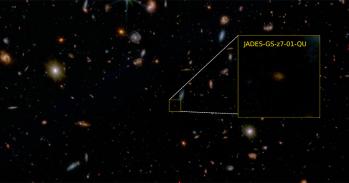
New insights into solar activity have been revealed thanks to research from a group of Cambridge academics.
New insights into solar activity have been revealed thanks to research from a group of Cambridge academics.
The more detail we see, the more challenging it is to explain!
Dr Helen Mason
The work comes from the Atomic Astrophysics Group (AAG) at the University's Department of Applied Mathematics and Theoretical Physics, who have been collaborating on an international solar mission, the Hinode project, with a number of space agencies.
Their research involves detailed analyses of regions of intense activity in the Sun's atmosphere, the corona. Through examination of the ultraviolet radiation given off by these areas, known as active regions, they have found a variety of dynamic activities, including jets and flows of gas with speeds of up to 150 kilometres per second.
Temperatures within the corona are extremely high (in excess of one million degrees), whereas the solar surface is much cooler at about 6000 degrees. AAG has been seeking to understand why the corona is so hot and what the linkages are between the solar surface and atmosphere.
For the first time, the team have been able to measure physical characteristics, such as the density and temperature of features of the solar atmosphere in great detail. They found strong connections between changes in the magnetic field of the solar surface and events in the overlying active regions.
These new insights have been made possible through the Hinode spacecraft, which has provided unprecedented views of the Sun. The AAG team work mainly with the EUV Imaging Spectrometer (EIS), led by the UK.
Cristina Chifor, a graduate student with AAG, said: "Since its launch, Hinode has been returning exciting new results. Last year, I had the opportunity to go out to Japan, visit the institute where Hinode is operated, and carry out the daily planning of Hinode/EIS observations.
"It was great fun to be able to 'drive' an instrument so far away in space and to see the data coming down from the spacecraft shortly after. It was a fantastic experience, and Japan is a wonderful place to visit."
Their results will further our understanding of solar phenomena which can affect the Earth's environment. Active regions on the Sun can produce huge explosions of gas, which can damage satellites and cause aurora (as seen, for example, in the Northern Lights). They will also increase our knowledge of stars in general.
Dr Helen Mason, group leader for AAG and Senior Tutor at St Edmund's College, said: "The Hinode satellite is providing us with some stunning new observations. We can see the Sun in far more detail than we were previously able to. The more detail we see, the more challenging it is to explain! I am so pleased that a younger generation of solar researchers have the opportunity to experience the excitement of working on new solar space observations."
AAG has 'swept the board' with their results, having four papers published in a special issue of Astronomy and Astrophysics (Vol 481) and one of their images (from C. Chifor et al.) on the front cover.
The Hinode spacecraft was launched in September 2006, as a joint UK, European, US and Japanese mission. The mission is operated by Institute of Space and Astronautical Science and Japan Aerospace Exploration Agency in collaboration with NASA, European Space Agency, Science and Technology Facilities Council and Norwegian Space Centre.
This work is licensed under a Creative Commons Licence. If you use this content on your site please link back to this page.





